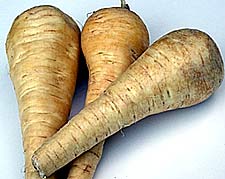Parsnip - grow a hardy root vegetable for winter
VEGETABLE PAGES
PARSNIP VARIETIES
Short Rooted Parsnips
Evesham
Avonresister (resistant to canker)
Intermediate
White Gem
The student
Offenham
Panache
Long Rooted
Improved Hollow Crown
Tender and True
SOCIETIES
PARSNIP
 Parsnips
are a very hardy root crop vegetable. They can be left over winter to
stand in places too cold for carrots, turnips or other vegetables.
Parsnips
are a very hardy root crop vegetable. They can be left over winter to
stand in places too cold for carrots, turnips or other vegetables.
But to produce large roots parsnips need a good start as they are slow growers.
The earlier that parsnip seeds can be sown the better - parsnips are usually sown in late February or early March, to be ready for use from late October.
To achieve the best results the seed bed needs to be reasonably dry and crumbly. So wait a few weeks before sowing parsnip seed if the soil is wet and sticky.
DIFFERENT TYPES OF PARSNIP
There are three types of parsnip - long, intermediate and short-rooted.
The short rooted varieties of parsnip can be grown in shallow soils and are similar to turnips in shape.
PREPARING THE GROUND FOR PARSNIPS
Parsnips are best grown on ground that was manured well from a previous crop. This is because freshly manured ground is more than likely to cause the roots to fork.
Avoid stony ground or the parsnip roots will be deflected and the parsnips will become misshapen.
Dig the ground deeply and leave rough until sowing time. Then break it down to a fine texture.
Rake in a mixture before sowing parsnips of 3oz of superphosphate, 1oz of sulphate of ammonia, and 1oz of sulphate of potash to the square yard.
SOWING PARSNIP SEED
A good way to keep nice straight lines of parsnips is to use an old broom handle gently pushed into the soil about 1 inch deep.
Make the drills for your parsnips I inch, deep and 12 inch apart.
Sow 3 or 4 parsnip seeds together. Then rake the soil over the drills lightly to cover the seeds.
Parsnips generally germinate in about three weeks, but this can vary. When the parsnip seedlings are large enough to handle, thin them down to 6 inches apart.
PARSNIP CULTIVATION AND HARVESTING
Do not let the soil dry out completely - water when very dry conditions prevail.
Regularly hoe between the parsnips to keep the weeds down.
Keep a look put for any signs of disease or Pests attacking your Parsnips
When the top growth dies down during winter you can leave the parsnips in the ground and lift as needed.
Around November you should lift a few parsnip roots as a standby supply in case the ground becomes frozen.
If you still have some roots in the ground by the following February pull them and store.
A good way to extract parsnip roots from the ground is by digging a trench alongside the row - this makes it easier to get at the parsnips without breaking them.
STORING PARSNIPS
Cut the green tops off and lay the parsnip roots on a bed of dry sand or soil in a suitable box.
Then cover the layers of parsnips with more sand or soil. Store in a dry well ventilated shed.
Store in complete shade to prevent the parsnips from sprouting. As added protection from sprouting you can put an extra layer of sand or soil on top.
OTHER USEFUL ARTICLES ON GARDEN GROWER
How to grow parsnip roots in the vegetable garden